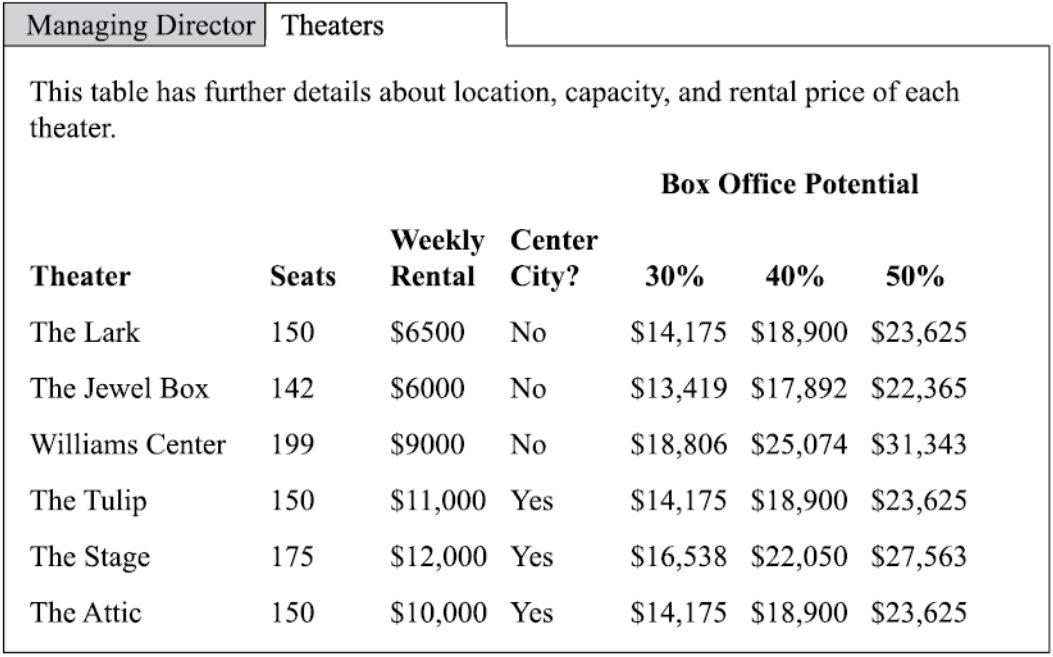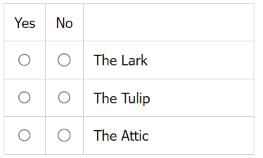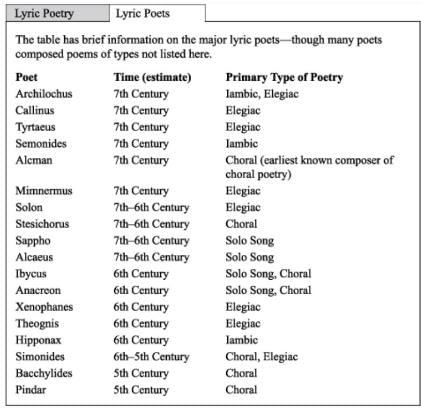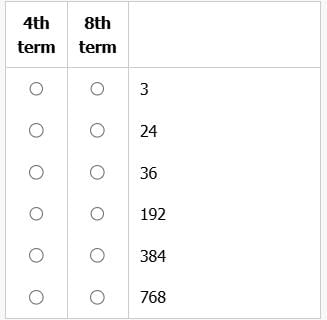Test: Data Insights - 1 - GMAT MCQ
20 Questions MCQ Test - Test: Data Insights - 1
Find the mean of the data.
1. The data has 8 data values
2. The data is 3, 4, 5, 6, 4, 1, 0, 5
1. The data has 8 data values
2. The data is 3, 4, 5, 6, 4, 1, 0, 5
Managing Director
Message from the Managing Director of a theater company to the Artistic Director
I have information about six theaters that could be suitable for our upcoming production. Their capacities range from 142 seats to 199 seats, and their rental rates range from $6000 per week to $12,000 per week. Location ac-counts for much of the difference in prices: Theaters in Center City are pricier than the others. On the other hand, we are likely to sell more tickets in a centrally located theater than in one of the others. Judging by our recent productions, I think that we should be able to achieve 50% of our weckly box office potential (that is, 50% of what we would earn in a weck if we sold all tickets to all performances at the maximum price) in Center City. Otherwise, 40% is a more reasonable expectation.
Take a look at the attached table for more details.

For each of the following theaters, select Yes if the managing director believes it is reasonable that each week the theater company will be able to earn more than $13,000 above the weekly rental price at that theater. Otherwise, select No.


Stephenson, a businessman bought an Iron box for $80. Determine his profit.
1. He made a 30% profit.
2. His selling price was $104.
Lyric Poetry
A team of classicists is examining some newly discovered manuscripts of ancient Greek lyric poetry, keeping in mind the following background information: Lyric poetry is a broad term used to describe the poems that were not epics or drama, and which were composed from roughly the 7th century BCE through the middle of the 5th century BCE.
The content of these poems spanned a wide range. While the Greck epics and tragedies dealt almost exclusively with the myths of Greece’s past, lyric poetry, though at times using a mythic background, kept its focus mostly on the present. Stylistically, lyric poetry had a wide variety, as well. Choral songs, such as eulogies, dithyrambs, dirges, and victory odes, were performed by a chorus and an accompanying instrument, usually on public occasions. Solo songs, also accompanied by an instrument, were typically of a more personal nature, with love as their chief subject. Alcaeus’ poetry provided a partial exception as solo songs go, for he also composed songs about politics as well as hymns to the gods.
Besides choral and solo songs, lyric poetry included elegiac and iambic poems, which may or may not have been performed to music. Elegiac poems are defined by meter, and the elegiac couplet, and were usually political or ethical exhortations. Iambic poems were usually polemics, or monologues of a satirical or salacious nature, often, but not always, composed in the iambic meter. Archilochus used iambics and trochaics for his poetry, whereas Hipponax was unique in his use of the choliambic meter.
Lyric Poets

For each of the following statements about a newly discovered poem that was composed in the choliambic meter, select Yes if it can be reasonably inferred from the given information. Otherwise, select No.

Ann deposited $3000 in her bank account at the beginning of the year. Determine the amount the funds accumulated to.
1. The bank offered 4.3% interest rate.
2. The amount was deposited for a period of 5 years.
In 2010, there were four used-car dealers in City Z. The graphic shows the monthly sales data for 2010 for two of those dealers as well as the citywide average for used-car dealers for those months.
Based on the given information, use the drop-down menus to most accurately complete the following statements.
1. ABC Cars and XYZ Automotive accounted for ____half of all used-car sales in City Z for 2010.
2. In June 2010, the two used-car dealers that are not specified by the graphic sold a total of exactly _____ cars.
Lyric Poetry
A team of classicists is examining some newly discovered manuscripts of ancient Greek lyric poetry, keeping in mind the following background information: Lyric poetry is a broad term used to describe the poems that were not epics or drama, and which were composed from roughly the 7th century BCE through the middle of the 5th century BCE.
The content of these poems spanned a wide range. While the Greck epics and tragedies dealt almost exclusively with the myths of Greece’s past, lyric poetry, though at times using a mythic background, kept its focus mostly on the present. Stylistically, lyric poetry had a wide variety, as well. Choral songs, such as eulogies, dithyrambs, dirges, and victory odes, were performed by a chorus and an accompanying instrument, usually on public occasions. Solo songs, also accompanied by an instrument, were typically of a more personal nature, with love as their chief subject. Alcaeus’ poetry provided a partial exception as solo songs go, for he also composed songs about politics as well as hymns to the gods.
Besides choral and solo songs, lyric poetry included elegiac and iambic poems, which may or may not have been performed to music. Elegiac poems are defined by meter, and the elegiac couplet, and were usually political or ethical exhortations. Iambic poems were usually polemics, or monologues of a satirical or salacious nature, often, but not always, composed in the iambic meter. Archilochus used iambics and trochaics for his poetry, whereas Hipponax was unique in his use of the choliambic meter.
Lyric Poets
For each of the following statements about the newly discovered manuscripts, select Yes if it can be reasonably inferred from the given information. Otherwise, select No.
The table gives information on 12 new home addition and renovation projects, in competition for inclusion in a television program featuring innovative styles. The producers of the program intend to make a selection based on one or more of the following criteria: city section (among a total of four), size in square feet of the project, cost of the project in dollars, and rating of innovativeness.
The following statements pertain to various possible selection criteria. Select Yes if the statement must be true on the basis of the given information; otherwise select No.
Chris has the option to order parts from either of two suppliers. Supplier A offers free shipping but prices items an average of 3.5% higher than Supplier B. Supplier B offers the lower prices but will add a shipping charge to all orders. The shipping charge is $7.50 on orders less than $200, $12.50 on orders from $200 to $500, and $15 on orders over $500. Chris finds Supplier A to be more economical for small purchases but wonders if there is an order size for which Supplier B would be cheaper.
Find the smallest value of an order from Supplier A for which an identical order from Supplier B would be cheaper. If an order costs $401.50 from Supplier A, what will the same order cost from Supplier B?
What is the value of the positive number, p?
1. One of its divisors is 7.
2. p is divisible by two positive numbers only
A company that designs websites primarily for minority-owned businesses conducted a survey of minority-owned businesses in the United States that do not currently have a website. The survey was designed to help determine what respondents see as the potential benefits of adding a website. The results of that survey are shown in the table.
For each of the following conclusions, select Supported if it is supported by the information in the table. Otherwise, select Not supported.
A newly launched small and medium enterprise (SME) company is seeking a loan to support its new project. The company has received loan proposals from two different banks. As per the proposal from Bank A, the company will be provided with an amount of $250,000 at a simple interest rate of 5% per year. The repayment will be made in 12 equal monthly installments, which will include both the principal amount and the interest.
On the other hand, Bank B has offered to provide 125% of the amount proposed by Bank A, with a simple interest rate of 4%. The repayment will also be made in 12 equal monthly installments, including both the principal and the interest.
In the table below, select in column 1 the remaining amount to be paid after six payments, as per the proposal of Bank A, and in column 2 the remaining amount to be paid after nine payments, as per the proposal of Bank B:
Find the common difference of the arithmetic sequence.
1. The third term of the sequence is 1.428.
2. The first and the fifth terms of the sequence is 1 and 1.856.
The table lists all the employees of the Metro Corporation’s human resources department. Each employee's immediate supervisor is identified by the supervisor’s employee ID number displayed in the last column on the right of the table. If one employee, say A, supervises another, say B, then A also supervises every employee supervised by B. Note that the hire date is given in the format month/day/year.
For each of the following, select Yes if it identifies an employee who, within the human resources department, supervises no one and who has at least 5 supervisors within the human resources department above her or him. Otherwise, select No.
Determine the price of two type A footballs if the total cost of a type A and a type B football is $500.
1. Type B football costs $200.
2. Two type A and three type B footballs costs $1200.
The Quasi JX is a new car model. Under ideal driving conditions, the Quasi JX’s fuel economy is E kilometers per liter ( E ) when its driving speed is constant at S kilometers per hour ( S
).
In terms of the variables S and E , select the expression that represents the number of liters of fuel used in 1 hour of driving under ideal driving conditions at a constant speed S , and select the expression that represents the number of liters of fuel used in a 60 km drive under ideal driving conditions at a constant speed S. Make only two selections, one in each column.
A sock drawer contains 36 pairs of socks, which are colored white, brown, or black, in some combination as follows:
- 5 pairs are colored with all three colors;
- 25 pairs have some white;
- 28 pairs have some brown;
- 20 pairs have some black.
In the table, select the number of pairs that have only one color and the number of pairs that have exactly two colors. Make only two selections, one in each column.
The ratio of water to alcohol in a completely filled 14 cup container is 2:5. Determine the new volume of the liquid in the container.
1. Water is increased by 14%.
2. A mixture whose ratio of water to alcohol is 4:5 is added to that in the container.
A sequence is defined such that each term is twice the value of the previous term in the sequence (so the fourth term is twice the value of the third). Which of the following could represent the 4th and 8th terms of such a sequence?




















